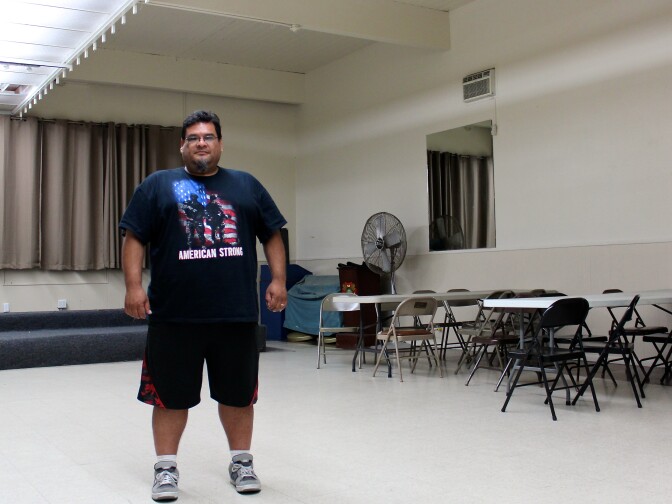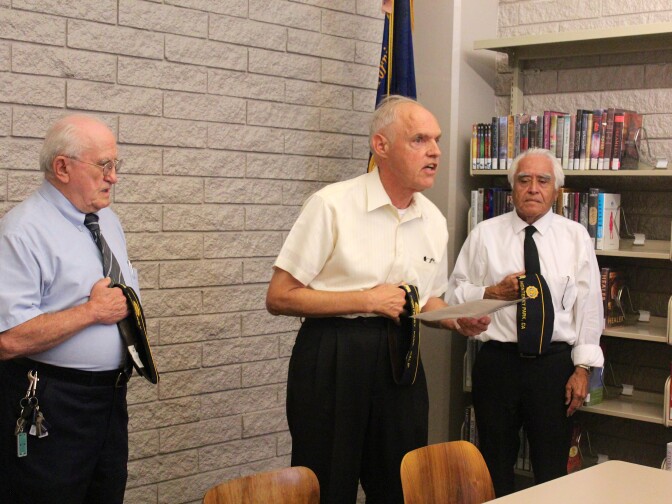With our free press under threat and federal funding for public media gone, your support matters more than ever. Help keep the LAist newsroom strong, become a monthly member or increase your support today.
To survive, American Legion needs younger veterans
Since 1928, American Legion Post 397 has drawn veterans from Monterey Park and beyond to its hall for potluck meals, benefits for sick kids and karaoke nights. But lately, the post has been struggling, as it loses aging veterans who used to make up its core membership.
“Unfortunately, they’ve passed on and gone on to our everlasting post,” said the Commander Gabriel Sanchez. Membership is down to 115 veterans, less than half of what it was 20 years ago. Money is so tight, the post can’t afford the $20,000 it will cost to fix the water-damaged roof.
"If we get termites, it will really ruin the roof, and if we don’t have a roof, we don’t have a hall to rent out," Suarez said.
Budget woes, declining membership — that’s the story for hundreds of American Legion posts around the country, as well as for other service organizations, including the Veterans of Foreign Wars and Disabled American Veterans. The obvious response would be to recruit new blood, and Post 397 is trying, by setting up a Facebook page and donating its space for Halloween parties for younger veterans.
But the American Legion faces a visibility problem. Ask 23-year-old Navy veteran Jeanetta Landrum what the American Legion is, and she said. “I’ve heard of it,” Landrum said.
“Never heard anything about it," she added.
Even Marco Urias, a 32-year-old Coast Guard veteran works in Veteran Affairs at Cal State Los Angeles, said he doesn’t know much about the American Legion “other than that they have discounted libations there.”
Remaking the image of the American Legion
The American Legion knows that to attract new members, it has to fight the image of simply being a watering hole.
“We are doing job fairs,” said Matt Herndon, who works in membership at the American Legion. “We’re assisting with VA claims. We even have programs to assist veterans in the event their home is damaged in natural disasters.”
Herndon said since the Legion’s founding in 1919, the group has lobbied for veterans in Washington.
“We’ve been instrumental in national awareness with post-traumatic stress disorder and traumatic brain injury," Herndon said.
But the group can’t do this work without dues from members, whose numbers have tumbled from 3.3 million in the 1990s to 2.3 million today. Herndon said part of the problem is American Legion halls are no longer the social hubs they were in the post-World War II era.
“That was the place to go,” Herndon said. “They were having dances, a lot of things socially. There just wasn’t a lot of other things to compete with at the time.”
Another issue: The pool of potential new members is smaller. The population of Americans in the military is now less than 1 percent.
“That’s a very low number compared to previous generations of veterans,” said Jason Hansman of Iraq and Afghanistan Veterans of America. “They’re more widely spread across the country, not in major cities.”
Recruiting new members in the digital age
Hansman said his group has begun organizing virtual veteran halls where people talk online about their deployments and returning to civilian life.
“We at IAVA are betting that a physical space is not a necessity for organizing or having a community of veterans across the country,” Hansman said.
Hansman added when veterans do want to meet in-person, they just set up events on Facebook. Sometimes younger veterans do meet-ups at American Legion posts. But rarely does it translate into new member sign-ups.
Urias, who works with veterans at Cal State L.A., said there’s things posts can do to stay relevant, like creating a workout space. "Vets typically like to work out or do something," Urias said. "Having a few weights or a bench — that may attract some foot traffic."
Gaming stations could also be a draw. “I’m 32, and that’s a way for me to decompress,” he said. “And some of my students are big gamers.”
Post member Herb Aguirre, a Korean War veteran, is old-school when it comes to technology. No email, despite the protests of his kids. He likes face-to-face interaction.
“I tell younger veterans, just come and see,” Aguirre, 83, said. “You’ll be surprised of little things we have. We have a pool table. We sit outside. You could order a drink or buy a soda.”
Visitors also have the opportunity to hear war stories from older veterans. Aguirre recalls the battles he survived in the Korean War: “Like they say, 'hell broke loose,' and I was lucky to make it."
For those who stop by, Aguirre's happy to show his scars. He's there most Tuesdays, working the bar.
The post has managed to attract a few younger veterans. Like Jose Sanchez, a 38-year-old MBA student at Cal State L.A. who also works as a veteran benefits coordinator there.
He joined a couple years ago and said he enjoys the company of the older veterans.
"The heart of a soldier, the heart of a warrior, is always there, so we always find things to have in common," he said.
But he said he is so busy with school, and the family he's raising, that he's only had time to visit the post a few times.
This piece is part of KPCC's ongoing coverage of issues affecting veterans for Veteran's Day 2014. See more of our coverage at KPCC.org/vets.














